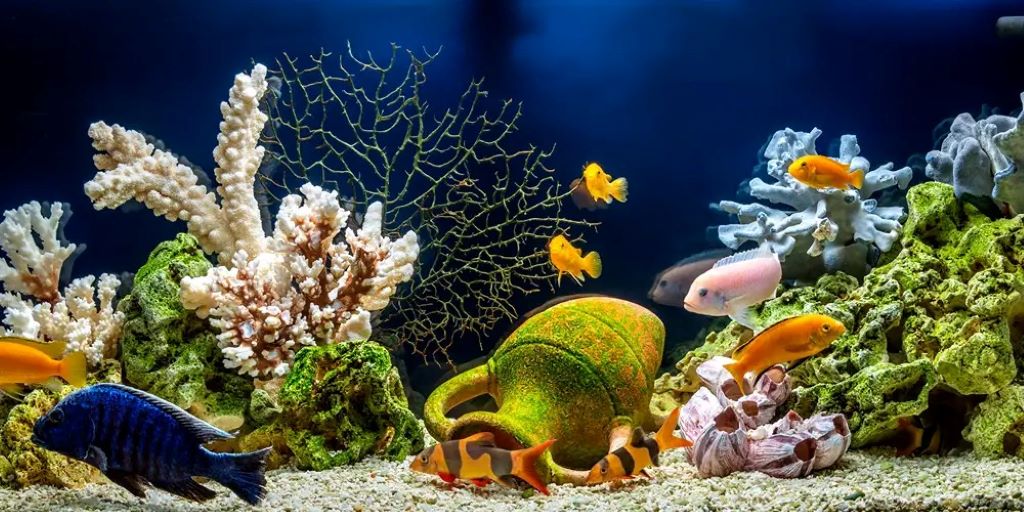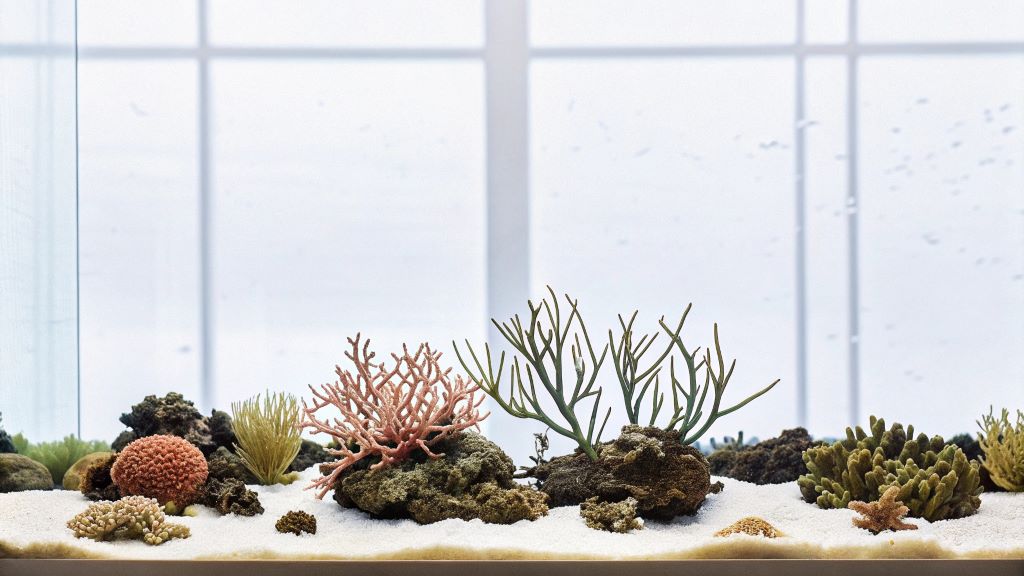Creating a stunning reef aquascape goes far beyond simply placing rocks and corals inside a tank. It demands a thoughtful approach that balances aesthetics and functionality to mimic nature’s underwater beauty while supporting marine life. Designing a visually balanced and functional reef aquascape is both an art and a science, involving principles of composition, biology, and physics.
The Foundation: Why Visual Balance Matters in Reef Aquariums
Visual balance refers to the harmony between different elements inside the reef tank, such as rock formations, corals, and open space. Without balance, the aquascape can appear cluttered or unnatural, which detracts from its appeal. According to a 2022 survey by the Marine Aquarium Society, 68% of hobbyists found that visual balance was a key factor influencing their enjoyment and maintenance success.
Visual balance encourages the eye to flow naturally across the tank, highlighting focal points such as colorful corals or interesting rock textures. Additionally, an intelligently balanced layout improves water flow and light penetration, both crucial for coral health and growth. Therefore, aesthetics and function go hand in hand.
Step 1: Choosing the Right Rock Structure
Rock forms the backbone of any reef aquascape. The choice and arrangement of rocks set the stage for coral placement, fish movement, and filtration efficiency. Experts recommend using live rock because it hosts beneficial bacteria that break down waste products, essential for biological filtration.
A popular method involves creating a “golden ratio” or “rule of thirds” layout. For example, positioning a rock mound off-center, covering about one-third of the tank’s bottom area, helps create dynamic asymmetry. This approach prevents the setup from feeling too rigid or artificial. Moreover, leaving negative space around the rocks promotes healthy water circulation.
However, some aquarists prefer a more natural “reef wall” design, resembling underwater cliffs found in the ocean. This style enhances shelter for fish but requires careful planning to avoid dead spots where detritus can accumulate.
Step 2: Coral Placement – Function Meets Beauty
Corals come in various shapes, sizes, and lighting needs. Placing them strategically ensures both visual appeal and longevity. SPS corals (small polyp stony) thrive under intense light and strong water flow, so they belong near the tank’s upper and front areas. Conversely, LPS corals (large polyp stony) prefer moderate light and less flow, suited for mid or lower zones.
Mixing coral types and colors thoughtfully creates contrast, enhancing visual interest. For instance, bright green montipora adjacent to purple acropora offers striking color balance. Coral aquascaper Brian Gin recently noted that varied coral textures contribute to depth perception and invite viewers to explore the tank visually.
Beyond aesthetics, coral placement impacts feeding and growth. Placing corals too close risks chemical warfare or shading. Experts advise maintaining at least 2 to 3 inches between species to prevent aggression.
Step 3: Lighting and Water Flow—Crucial Functional Components
Proper lighting mimics natural sunlight and drives photosynthesis in zooxanthellae, the algae living symbiotically inside corals. Over 70% of reef aquarists confirm that LED lighting systems with adjustable spectrums offer the best balance of intensity and energy efficiency. Additionally, setting a gradual sunrise-to-sunset light cycle reduces coral stress.
Water flow prevents detritus buildup and delivers oxygen and nutrients. Strategic placement of powerheads ensures turbulent, randomized flow rather than one-directional currents. This setup replicates ocean waves, essential for coral health. Without good flow, corals can suffocate or suffer from tissue necrosis.
Step 4: Incorporating Functional Open Spaces
While a densely packed reef may seem appealing, functional open spaces within the aquascape provide swimming areas for fish and help maintain water quality. These gaps also make maintenance easier, allowing better access to clean surfaces and remove detritus.
Aquascaper experts suggest maintaining at least 20% of tank volume as open swimming space. This balance keeps the environment lively and prevents overcrowding, which often leads to aggression or stress in fish.
Step 5: Using Color Theory and Texture
Color theory plays a powerful role in creating harmony. Contrasting coral colors like blues and oranges, or greens and purples, generate vibrant displays. Additionally, mixing smooth and rough textures offers visual depth. For example, pairing soft leather corals alongside branching staghorn provides tactile contrast.
Aquascapes with monochromatic tones may appear dull, while excessive color mixing can confuse the eye. Striking a balance enhances engagement and makes the reef more inviting.
Real-World Examples and Case Studies
Take the award-winning reef aquascape by oceanographer David Li, who designed a tank mimicking Pacific reef topography. Li balanced tall rock pinnacles with sweeping coral gardens, creating both vertical and horizontal interest. His design also prioritized water flow channels around each coral cluster, minimizing algae buildup.
In another example, a reef aquarist on Reef2Reef.com described how shifting coral placement based on light intensity and flow drastically improved coral coloration and growth within months.
Featured Snippet: How to Design a Visually Balanced and Functional Reef Aquascape
Question: What are the key steps to designing a visually balanced and functional reef aquascape?
Answer: Start by selecting a solid rock structure arranged using the rule of thirds for natural balance. Place corals according to their light and flow needs to maximize health and visual appeal. Ensure open swimming spaces for fish and proper water circulation with powerheads. Use contrasting coral colors and textures to add depth. Finally, choose lighting that mimics natural sunlight cycles, promoting coral growth and a vibrant tank environment.
Expert Tips for a Thriving Reef Aquascape
- Test water parameters regularly to keep them within optimal ranges: temperature (75–80°F), salinity (1.023–1.025), and pH (8.1–8.4).
- Use natural sand or fine substrate to support bottom-dwelling species and beneficial bacteria.
- Avoid overcrowding rocks and corals; give each element enough room to grow.
- Invest in a quality protein skimmer to reduce organic waste.
- Monitor coral aggression signs and rearrange if needed.
Frequently Asked Questions
- How important is rock placement for reef aquascaping?
Rock placement is critical. It affects water flow, coral growth, and tank aesthetics. - Can I mix different coral types in one aquascape?
Yes, but maintain proper spacing to prevent coral aggression. - What lighting is best for reef aquariums?
LED lights with adjustable spectrums offer energy efficiency and customizable intensity. - How much open space should I leave in my tank?
At least 20% of the tank should remain open for fish movement and maintenance. - Does coral texture impact tank design?
Yes, mixing textures enhances visual depth and interest. - How do I prevent algae buildup?
Maintain proper water flow and avoid overfeeding fish. - Is live rock necessary?
Live rock improves biological filtration and provides habitat for marine organisms.
Final Thought
Designing a visually balanced and functional reef aquascape combines creativity with scientific understanding. It requires careful planning of rock formations, coral placement, and environmental factors such as lighting and flow. This thoughtful approach not only results in a breathtaking underwater display but also fosters a healthy ecosystem for marine life. Remember, patience and continuous learning transform your reef aquarium into a mesmerizing slice of ocean paradise.
Read More:
How to Choose the Right Aquarium Heater for Your Fish







